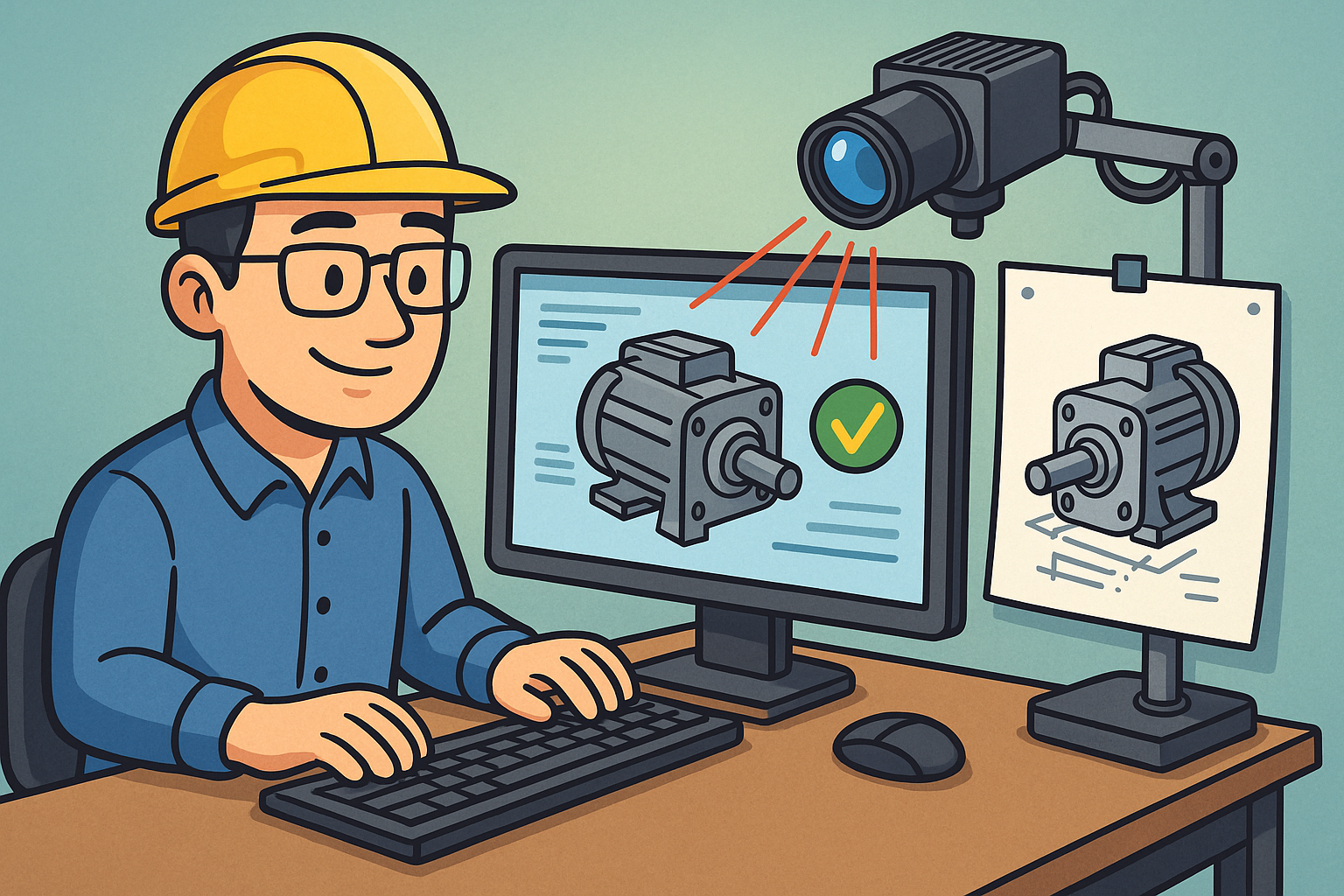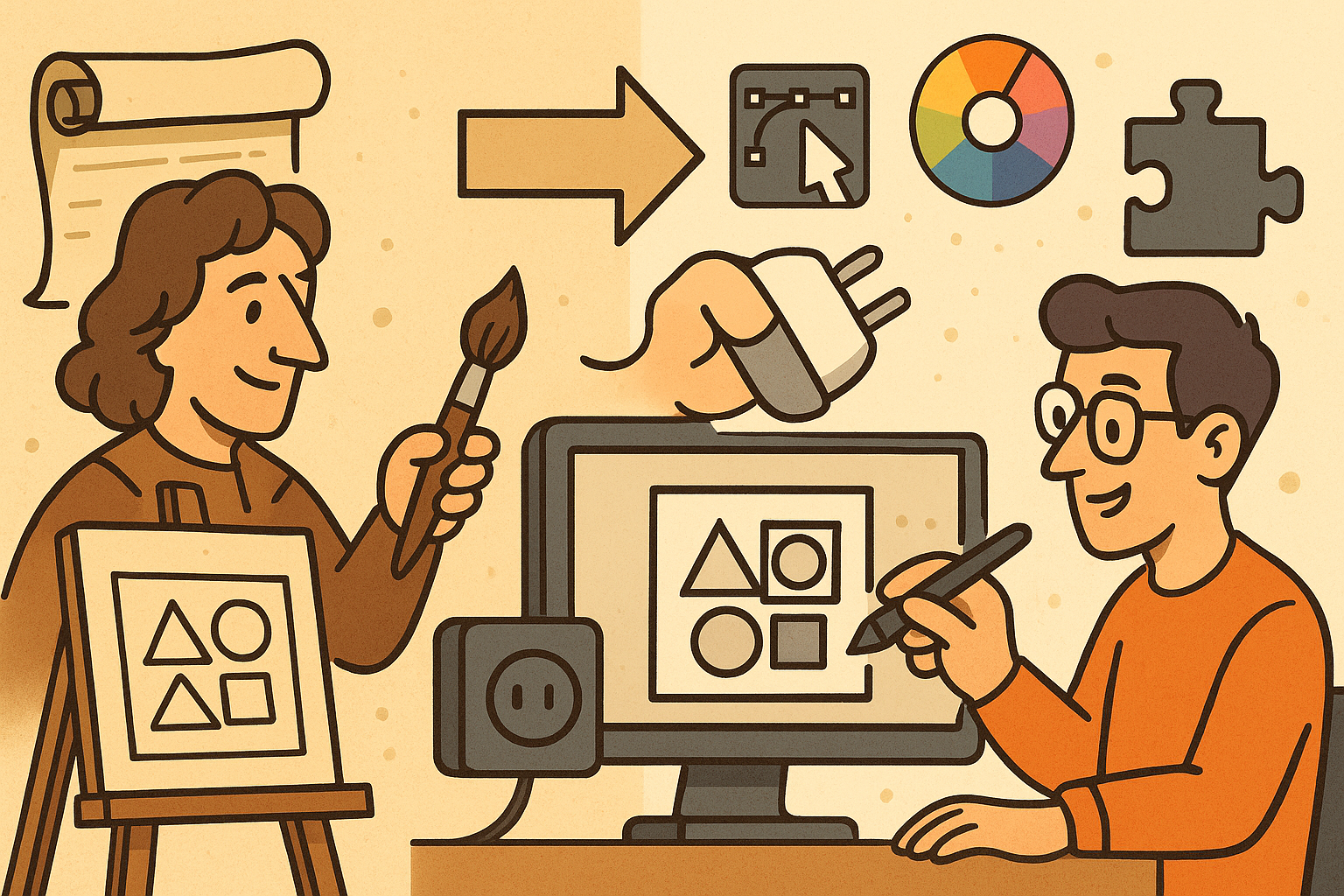Your Cart is Empty
Customer Testimonials
-
"Great customer service. The folks at Novedge were super helpful in navigating a somewhat complicated order including software upgrades and serial numbers in various stages of inactivity. They were friendly and helpful throughout the process.."
Ruben Ruckmark
"Quick & very helpful. We have been using Novedge for years and are very happy with their quick service when we need to make a purchase and excellent support resolving any issues."
Will Woodson
"Scott is the best. He reminds me about subscriptions dates, guides me in the correct direction for updates. He always responds promptly to me. He is literally the reason I continue to work with Novedge and will do so in the future."
Edward Mchugh
"Calvin Lok is “the man”. After my purchase of Sketchup 2021, he called me and provided step-by-step instructions to ease me through difficulties I was having with the setup of my new software."
Mike Borzage
Revolutionizing Design Validation with Machine Vision Technology
October 20, 2025 9 min read


Introduction to Machine Vision in Design Validation
Machine vision has emerged as a transformative technology in the realm of design validation, revolutionizing how modern design processes are executed. Over the past few decades, rapid developments in imaging hardware, sensor technology, and computational power have paved the way for new methods of inspection and quality assurance. The evolution of machine vision is now deeply intertwined with advances in algorithms and data processing techniques, leading to a paradigm shift in the design and validation domains. In today’s highly competitive environment, the integration of machine vision into design workflows is not just advantageous — it is essential for achieving precision in prototypes and final products alike. This convergence of disciplines has introduced **design validation** as a critical step in modern design processes, ensuring that every detail is verified against stringent quality standards. By incorporating machine vision tools, designers can automate many previously manual tasks, thereby accelerating development cycles and improving overall product quality.
Advancement of Machine Vision Technology
The technology behind machine vision has matured over time, evolving from basic image capture devices to intricate systems that analyze and interpret visual data. Early systems primarily served to capture images, but modern machine vision employs robust techniques such as deep learning and **AI-driven image processing** to evaluate and predict outcomes with unparalleled accuracy. Components such as high-resolution cameras, specialized optics, and industrial lighting form the hardware backbone, while sophisticated algorithms provide the software capabilities necessary to interpret complex patterns and anomalies. This integrated approach enables designers to quickly identify deviations and inconsistencies during the design process, which previously required painstaking manual inspection. In many industries, machine vision now plays a pivotal role in both the initial design assessments and later quality control phases, ensuring a consistent, error-free product development cycle.
The Critical Role of Design Validation in Modern Workflows
Design validation has evolved into a comprehensive process that verifies the functionality, aesthetics, and compliance of a product against predetermined specifications. By utilizing machine vision, companies can now validate designs in a way that minimizes human error, streamlines quality assurance steps, and reduces overall time to market. This process involves collecting visual data from numerous angles, compensating for variations in production, and automating inspection routines for even the most subtle defects. In practice, this means that intricate parts and assemblies can be scrutinized with a high level of detail, ensuring that every component meets the desired standards. The strategic application of machine vision in design validation results in improved consistency and reliability, enabling manufacturers to deliver products that adhere to both customer expectations and regulatory demands.
Transforming Validation Workflows with Integrated Machine Vision
Integrating machine vision into design validation processes fundamentally transforms workflows by automating data collection and analysis. This integration enables real-time monitoring and swift corrective actions, reducing the risk of costly downtime and production errors. Key benefits include enhanced accuracy, increased throughput, and the ability to scale up operations without a corresponding increase in labor intensity. The practical benefits of this technology are often realized through streamlined inspections, rapid identification of discrepancies, and detailed reporting — all of which contribute to continuous process improvement. Additionally, the use of **machine vision** makes it possible to predict potential design failures well before they enter the manufacturing stage, thereby saving time and resources. Such an overhaul in design validation methodologies is essential in today’s fast-paced market, where everyone is striving for improved performance and efficiency.
Key Technologies and Methods
A critical component in modern design validation is the integration of robust hardware and innovative software into the machine vision framework. At the core of this ecosystem lies an advanced mixture of high-resolution cameras, specialized sensors, and dedicated lighting systems, each contributing unique capabilities to the overall design validation process. On the software side, sophisticated algorithms are employed to process and analyze images, with techniques such as **pattern recognition**, machine learning, and deep convolutional networks at the forefront. These methods allow the system to not only detect anomalies but also understand complex design features and build data-driven models that predict future performance issues. The interplay between hardware and software forms an integrated environment that delivers precise, reliable monitoring and validation results every time a product moves through the development cycle. This integrated approach ensures that even the smallest deviations from acceptable standards are scrutinized before products move to mass production.
Hardware Components Empowering Machine Vision
Modern machine vision systems are built upon a dynamic hardware landscape that continuously advances to keep pace with the ever-increasing demands of design validation. At the forefront of this hardware architecture are state-of-the-art cameras that offer high resolution and rapid frame rates, enabling the capture of minute details in complex design elements. In addition, specialized sensors are utilized to gather data in environments that are often beyond the reach of the human eye, including infrared, ultraviolet, and hyperspectral imaging contexts. Key components include time-of-flight cameras for depth measurements, structured light systems for precise 3D reconstructions, and laser triangulation units that deliver pinpoint accuracy. Designers and engineers benefit from this wealth of hardware capabilities as they apply machine vision to validate and verify product dimensions, tolerances, and assembly alignments. This allows companies to maintain high levels of quality and consistency in rapidly evolving design workflows.
Software Algorithms and Analysis Techniques
The transformative impact of machine vision in design validation is largely driven by the evolution of robust software algorithms. **Pattern recognition** algorithms play an essential role by identifying and categorizing objects based on visual characteristics that might otherwise be misinterpreted, ensuring that the data captured is both actionable and meaningful. With the advent of deep learning, techniques have grown more sophisticated to the point where AI-driven image processing can learn and adapt from vast datasets. This leads to constantly evolving solutions where the algorithm refines its accuracy through repeated applications and exposure to new scenarios. Furthermore, advanced techniques like neural networks and support vector machines assist in filtering out unnecessary noise and focusing on critical areas of a design. These algorithms are particularly effective when used in tandem with high-performance computing systems, which allow for real-time data processing and feedback. Consequently, engineers can quickly pinpoint deviations and refine design parameters to achieve unmatched precision.
Practical Applications in Design Validation Processes
In real-world design validation scenarios, machine vision technologies are leveraged to enhance the standard workflows, translating into several tangible benefits. The implementation of advanced imaging systems and AI-driven analysis has allowed designers to detect subtle defects and irregularities that were previously undetectable. For instance, by integrating systems that utilize **deep learning** algorithms alongside traditional image scanning methods, companies are now able to conduct inspections that encompass multiple dimensions – including geometric, color-based, and texture features. The practical applications of these methods include automated edge detection, surface quality analysis, and thermal mapping, all of which help in identifying key areas of concern during design validation. Several operational environments make use of these advanced monitoring techniques, as they offer streamlined data collection and generate consistent, scalable outputs. This results in more efficient decision-making and significantly reduces the potential for costly design errors. Overall, machine vision represents a pivotal addition to modern design software validation, substantially improving reliability while also enhancing operational throughput.
- High-resolution cameras provide detailed images necessary for precise inspections.
- Pattern recognition algorithms help in accurately identifying design anomalies.
- AI-driven image processing offers scalable analysis and rapid corrective feedback.
Integration Challenges and Implementation Strategies
Integrating machine vision into established design workflows can bring a host of challenges, ranging from technical intricacies to cultural shifts within design teams. The technical hurdles mainly involve data compatibility, the integration of legacy systems, and ensuring the scalability of the new technology. Overcoming these challenges necessitates careful planning and iterative testing, as existing systems may require significant modifications to accommodate advanced vision technologies. Moreover, embedding this technology into design software platforms demands a comprehensive understanding of both the hardware and software intricacies behind the scenes. When properly implemented, machine vision systems can significantly enhance the design validation process; however, it is essential to adhere to best practices that account for both immediate and long-term integration impacts. This includes establishing clearly defined milestones for integration, training personnel on new software suites, and maintaining a continuous improvement mindset to adapt as systems evolve.
Technical Challenges in System Integration
The integration of machine vision systems with existing design software often encounters several technical hurdles that must be addressed systematically. One of the primary challenges is ensuring data compatibility between legacy systems and modern imaging technology. Historical design data may be stored in formats that are not readily accessible by cutting-edge algorithms, requiring data transformation and normalization routines. Another significant concern is the issue of system scalability; design environments often operate at various scales, from intricate component designs to full product assemblies, which necessitates a flexible and robust computational infrastructure. Moreover, real-time processing and feedback, which are critical features of machine vision, demand high-performance computing resources and efficient data pipelines. Overcoming these challenges involves a detailed analysis of current systems, adoption of scalable architectures, and deployment of middleware solutions that can bridge legacy technologies with new machine vision capabilities. For instance, middleware can help in linking data sources and ensuring seamless communication between different subsystems, thereby enhancing the overall efficacy of integrated platforms.
Best Practices for Integrating Machine Vision Tools
Implementing machine vision in design validation calls for adherence to a set of best practices that ensure smooth integration and operational excellence. One of the primary strategies is modular integration, where new functionalities are introduced incrementally rather than replacing entire systems overnight. This provides a safety net that minimizes potential disruptions and allows for the identification of compatibility issues early in the process. Further, it is crucial to maintain open lines of communication between software developers, hardware engineers, and end users to ensure that feedback from every stage of the process is effectively integrated into the development cycle. Comprehensive documentation, regular system audits, and ongoing training programs are fundamental components in successfully embedding machine vision within existing design frameworks. Additionally, utilizing simulation environments to test new functionalities before live deployment can greatly reduce unforeseen complications. As a result, companies often opt for a blended approach that leverages both in-house expertise and third-party consulting to address the transition phase smoothly.
Strategies for Training Design Teams and Continuous Improvement
Beyond technological integration, one of the most critical components in successfully adopting machine vision is the training of design teams. It is essential that all members understand both the theoretical underpinnings and practical applications of machine vision technology in enhancing **design validation**. Comprehensive training programs should include interactive workshops, detailed documentation, and ongoing support to ensure continual skill improvement. Emphasis should be placed on how modern tools facilitate faster error detection, reduce manual oversight, and enhance overall design outcomes. Additionally, fostering a culture of continuous improvement is vital; teams should be encouraged to provide feedback and share experiences regarding system performance and best practices. Regular review sessions, knowledge sharing forums, and updates on technological advancements help ensure that the integration of machine vision remains a dynamic, progressively improving process. To further support team development, organizations might utilize the following strategies:
- Regular knowledge-sharing sessions and workshops to familiarize staff with both hardware and software aspects.
- Hands-on training sessions with simulation environments that mimic real-world design challenges.
- Development of internal documentation outlining best practices and common troubleshooting steps.
- Implementation of feedback loops where teams can suggest improvements and share their experiences.
This multifaceted approach to training not only optimizes current operations but also prepares design teams for future upgrades and innovations in machine vision technology.
Conclusion
The integration of machine vision into design validation processes is revolutionizing the way design software platforms and engineering workflows operate. Through the adoption of advanced hardware and software systems, companies are now equipped to perform high-speed, high-precision inspections that reduce errors and boost overall productivity. Enhancing quality control, maintaining rigorous standards, and supporting continuous improvement are the foundations upon which these innovations rest, clearly demonstrating that embracing machine vision is not merely an enhancement but a necessity in today's design landscape.
Recap of Major Benefits
The journey from traditional manual inspection to automated, real-time validation enabled by machine vision is marked by significant improvements in efficiency and quality. Many advantages have emerged, including the dramatic reduction in processing time for quality checks, increased consistency in design verification, and enhanced predictive maintenance capabilities that preemptively identify potential issues well before they become critical concerns. These benefits are further amplified by the successful integration of **AI-driven image processing** and machine learning algorithms that continuously refine evaluation criteria, ensuring that every component meets the highest standards. Organizations that have adopted this technology have reported smoother operational workflows and a more proactive approach to design refinement. The systemic improvements enabled by machine vision blend seamlessly into existing frameworks, proving that the transformation in design validation is both profound and necessary.
Final Thoughts on Future Trends and Innovations
As the field of machine vision continues to advance, its capabilities in design validation are expected to expand exponentially. Emerging trends such as increased integration with Internet of Things (IoT) devices, edge computing, and further advancements in deep learning algorithms point to a future where design automation will become even more seamless and predictive. This will enable designers to not only react to defects but also foresee and mitigate potential failures during even earlier phases of product development. The intersection of machine vision with emerging technologies is set to push the boundaries of what can be achieved in precision engineering and product development. These innovations will likely drive the next generation of design software validation tools, ensuring that companies remain at the forefront of technological progress.
Call to Action for Design Professionals
In conclusion, design professionals are encouraged to explore and adopt machine vision solutions as part of their broader strategy to enhance **design validation** processes. The benefits of this integration are clear: improved precision, reduced manual errors, and a more agile response to the demands of modern design environments all point to a future where embracing these technologies will be indispensable. With clear evidence of measurable gains, the time is right for design engineers and software developers to invest in machine vision tools and to continuously update their workflows to incorporate these advancements. By doing so, they secure a competitive advantage and lay the groundwork for a more innovative, efficient, and high-quality approach to design.
Also in Design News

Design Software History: Historical Development and Impact of Plug-ins and Extensions in Design Software Evolution
October 20, 2025 8 min read
Read More
Cinema 4D Tip: Optimizing Game Asset Creation for Unity in Cinema 4D
October 20, 2025 3 min read
Read More
Bluebeam Tip: Enhancing Document Reviews with Bluebeam's Highlight Tool
October 20, 2025 2 min read
Read MoreSubscribe
Sign up to get the latest on sales, new releases and more …


